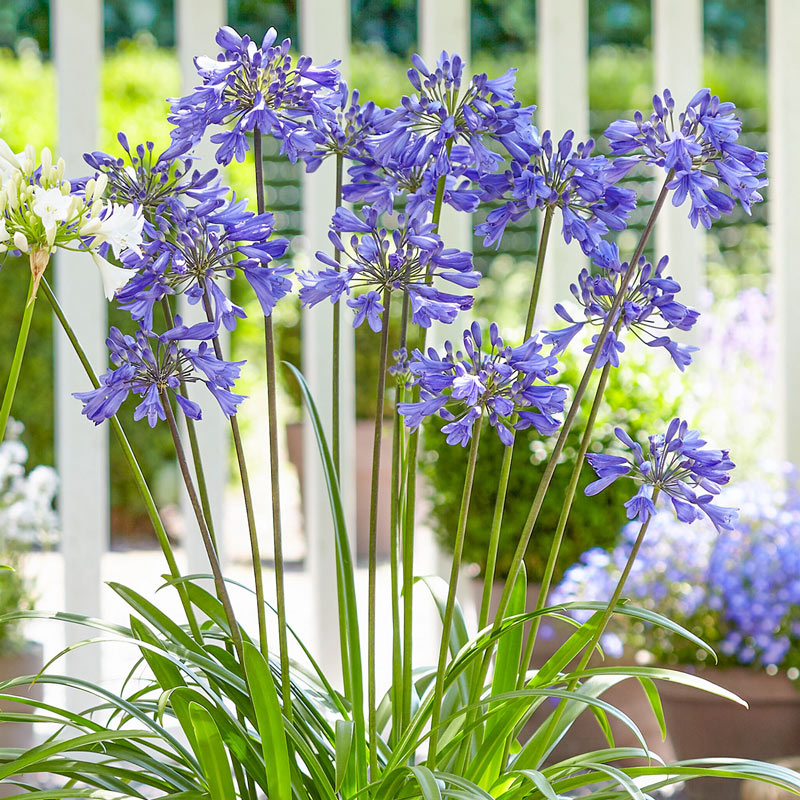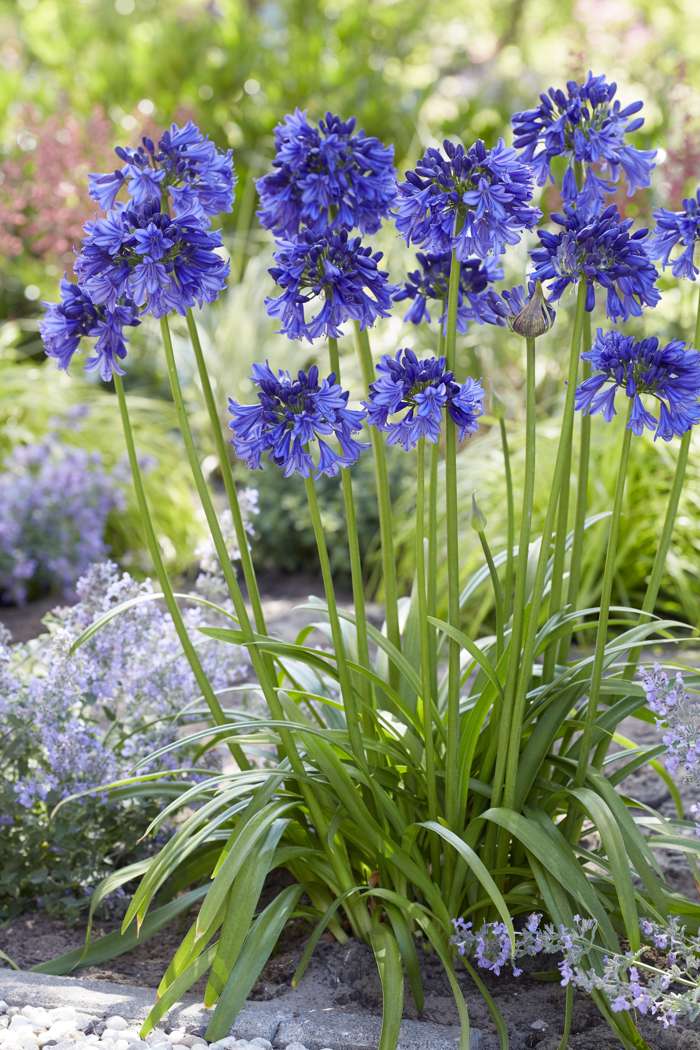Magnificent Agapanthus: Enhancing Your Yard's Appeal
Magnificent Agapanthus: Enhancing Your Yard's Appeal
Blog Article
Releasing the Secret to Successful Agapanthus Growing: Idea for a Flourishing Garden
In the world of gardening, cultivating agapanthus effectively calls for a critical method that encompasses various elements of plant care. By recognizing the nuances of agapanthus farming, one can develop an environment where these plants flourish and grow abundantly.
Growing Agapanthus: Finest Practices
When planting Agapanthus, appropriate dirt preparation is important for making certain effective development and development of these attractive flowers. Agapanthus, generally called Lily of the Nile or African lily, grows in well-draining soil with a somewhat acidic to neutral pH level - Agapanthus. Prior to growing, it is vital to amend hefty clay soils with natural matter such as compost or peat moss to boost drainage and offer crucial nutrients for the plants
To grow Agapanthus, pick a location that obtains full sunlight to partial color, as this will certainly promote healthy growth and plentiful blooming. Dig a hole twice the diameter of the plant's origin ball and place the Agapanthus at the exact same deepness it was previously expanding. Carefully backfill the hole with dirt, pushing down securely to get rid of any kind of air pockets around the roots.
Water the freshly planted Agapanthus thoroughly and remain to maintain the dirt equally wet, specifically throughout the plant's energetic growing period. Agapanthus. Applying a balanced fertilizer once a month can additionally sustain the plant's development and blooming. By adhering to these finest methods for growing Agapanthus, you can develop a magnificent display screen of these captivating flowers in your yard
Suitable Soil Issues for Agapanthus
For optimal development and growing success of Agapanthus plants, guaranteeing the soil problems are excellent is essential. Agapanthus prospers in well-draining dirt with a slightly acidic to neutral pH level ranging from 6.0 to 7.0. This sort of soil allows for sufficient water drainage, avoiding waterlogging which can cause root rot. To boost soil water drainage, take into consideration including natural issue such as garden compost or peat moss when preparing the growing website. Moreover, Agapanthus prefers soil that is rich in nutrients, so incorporating a well balanced fertilizer during the growing season can promote healthy development and lively blossoms.

Watering and Fertilizing Tips
To make sure healthy and balanced growth and vivid blossoms, appropriate watering and feeding methods are vital for successful Agapanthus farming. Agapanthus plants profit from routine watering, especially during the growing season.
When it involves feeding Agapanthus, a balanced plant food with equal components nitrogen, phosphorus, and potassium can be used in the spring to promote healthy and balanced development and flowering. Slow-release fertilizers are ideal for giving nutrients progressively over an extensive period. Avoid over-fertilizing, as this can lead to too much vegetation development at the cost of blooms.
In addition, integrating organic issue like compost into the soil can improve nutrient levels and enhance dirt framework, aiding in the total health of the Agapanthus plants. By adhering to these watering and fertilizing ideas, gardeners can guarantee their Agapanthus plants flourish and generate sensational display screens of blossoms.
Pruning and Deadheading Methods
Correct pruning and deadheading strategies play a vital role in preserving the wellness and appearances of Agapanthus plants, complementing the crucial techniques of watering and fertilizing for effective cultivation. Trimming Agapanthus involves removing spent flower heads, yellowing or dead leaves, and overall shaping of the plant to advertise better development. Deadheading, the procedure visit homepage of eliminating discolored blossoms, not only improves the plant's appearance however likewise motivates more blooming.
When deadheading Agapanthus, it is advisable to clip off the flower stem at the base utilizing sharp, tidy shears. This procedure redirects the plant's energy from seed manufacturing back into origin and vegetation growth, promoting a healthier and a lot more durable plant. Normal deadheading can extend the blooming period of Agapanthus and protect against self-seeding, which can lead to overcrowding.
In terms of trimming, Agapanthus usually try these out take advantage of a light trim after flowering to clean up the plant and encourage fresh growth. Reducing the spent blossom stems and getting rid of any dead or broken vegetation aids keep the plant's vitality and total appearance. Nevertheless, it is necessary to prevent reducing right into the crown of the plant, as this can deteriorate its health and wellness.

Protecting Agapanthus From Pests and Diseases
Executing effective pest and condition monitoring methods is important to protecting the health and vigor of Agapanthus plants in growing. Agapanthus are normally hardy check here plants, yet they can still come down with different insects and conditions if not correctly taken care of. One common parasite that affects Agapanthus is the Agapanthus borer, a caterpillar that tunnels right into the plant, causing damages to the flowers and leaves. To stop problems, regular examination of the plants is important. If borers are detected, they can be by hand removed, or insecticidal soap can be made use of as a control action.
Along with bugs, Agapanthus are vulnerable to conditions such as root rot and fungal fallen leave spots. These concerns can frequently be protected against by making sure correct drain and preventing overwatering. Impacted components of the plant need to be quickly eliminated to stop more spread if indicators of disease appear. Fungicides might also be used as a treatment step, complying with the supplier's guidelines carefully. By staying alert and resolving parasite and condition concerns promptly, garden enthusiasts can help their Agapanthus flourish and thrive.

Final Thought
To conclude, successful cultivation of agapanthus needs appropriate growing techniques, excellent dirt problems, ample watering and fertilizing, routine trimming and deadheading, and protection from illness and parasites. By following these suggestions and techniques, gardeners can make sure a growing garden loaded with lovely agapanthus flowers. Agapanthus. Bear in mind to keep regular treatment and focus to information to promote the health and wellness and durability of these magnificent plants
When growing Agapanthus, correct soil preparation is crucial for making certain successful development and advancement of these gorgeous flowers.Water the newly grown Agapanthus thoroughly and proceed to maintain the soil evenly damp, specifically throughout the plant's active expanding season.For optimal development and blooming success of Agapanthus plants, making sure the soil problems are ideal is crucial. When transplanting or growing Agapanthus, make certain the dirt is well-prepared to give the essential foundation for the plants to establish themselves successfully. One usual insect that impacts Agapanthus is the Agapanthus borer, a caterpillar that tunnels into the plant, causing damage to the blossoms and leaves.
Report this page